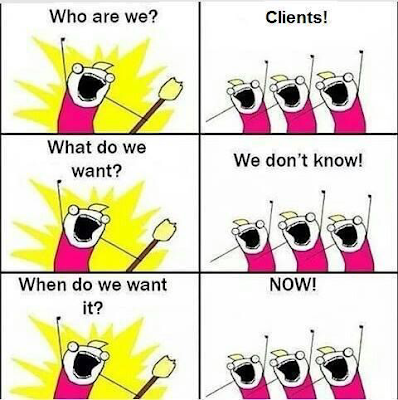The reasons why you’re nervous might vary – you haven’t done
much public speaking; or perhaps you have to put on a presentation with new and
unfamiliar material; maybe it’s a completely new audience you’ll be in front
of; or it could be that maybe you’re delivering it via a different method
(e.g., Skype vs. in-person).
Presenting virtually vs in-person is a subject I will leave
for a different day.
But, I’ve done all kinds of public speaking, so I will address this day some of the things
I’ve learned about doing so.
To begin with, I’d
offer up that everyone feels at least some level of anxiety before speaking in public. So, what you’re feeling is perfectly
normal.
Secondly, whether you are a novice public speaker or you do
so routinely, I would offer you that the best answer for giving a great
presentation is – are you ready for this? – the
same method as it’s been since probably the ancient Greeks first perfected
the art of oratory;
- BE PREPARED! STUDY! KNOW YOUR STUFF!
- Practice, practice, practice!
Yep. That’s alllll there is to it. Really.
A note of caution though; that’s also (in its own way) a
very big tasking. If it’s only a speech-type of presentation you should know
every key point of your talk and the supporting statements in it.
If it’s a training presentation, then you need to go beyond
that and know as much as possible about each key point - as in well beyond
those key points. That way you can anticipate audience questions and be better prepared
to answer them.
Take note; being as familiar as possible with the material
is only half the battle. The other
half is practicing your presentation. Practice is, IMHO, every bit as
important as the preparation.
Why? because it’s right here that you win the audience. It’s
in the practice phase that you 1) become ultra-familiar with the material, its order
and flow and when you are bringing what points to completion.
The practice phase is also where you perfect your tone, voice
inflections, rhythm and – this is often overlooked but is quite critical – you learn
where your vulnerabilities are. It’s THIS phase that allows you to make eye
contact with your audience (and keep it) during your talk. Why? Because you are
so familiar with the material and the order in which you’re presenting it – you’ve
practiced it over and over and over again - that you know what’s coming and
when it’s coming in the presentation. So,
you’re able to and comfortable enough to not stare at your speaker notes or the
visual aids you’re using in your talk (If
you’re using PowerPoint in your presentation, I’m lookin’ at you, here).
And…. If there’s any vulnerabilities in your talk, any emotional
threats to your speaker voice, this is where you’ll discover it and prepare
your defense to it.
Here’s an example of what I mean by a vulnerability; a few
years ago, I was asked to deliver the eulogy at a funeral. Like every other
talk I give or presentation I make, I made time in my schedule to rehearse this
eulogy multiple, multiple times. That way I not only knew when to accent what,
when to pause for effect etc so much that my delivery seemed utterly and
absolutely natural, but also I knew when
my voice was liable to crack with emotion.
What’s the “cure” for those vulnerabilities? Practice saying
them – out loud – again, again, again and again and again. Does that remove the
emotion? No. But, it helps you know when the vulnerable phrase is coming and
helps you condition your voice to stay strong and natural during those
particularly vulnerable phrases.
So, you have to put on a presentation in the near future…. And
you’re nervous about it. Cut yourself some slack and remember that everybody feels somewhat nervous before speaking in public. Then make some time in your
schedule to get as familiar with the topic list as you can. Then sequester yourself
someplace private for a few hours and practice it – out loud, with gestures and
increasing eye contact - as many times as possible.
If about now you’re thinking; “That doesn’t sound like
public speaking, that sounds like actors memorizing and saying lines in a play.”
To that, I’d say; “Yep. You’re right. Both situations utilize a lot of the same
techniques.”
So, go! Prepare! Practice! Then give that presentation! You’ll
do a smashing good job!